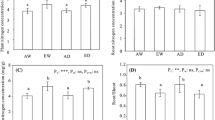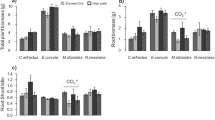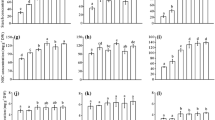Abstract
The eastern Colorado shortgrass steppe is dominated by the C4 grass, Bouteloua gracilis, but contains a mixture of C3 grasses as well, including Pascopyrum smithii. Although the ecology of this region has been extensively studied, there is little information on how increasing atmospheric CO2 will affect it. This growth chamber study investigated gas exchange, water relations, growth, and biomass and carbohydrate partitioning in B. gracilis and P. smithii grown under present ambient and elevated CO2 concentrations of 350 μl l−1and 700 μl l−1, respectively, and two deficit irrigation regimes. The experiment was conducted in soil-packed columns planted to either species over a 2-month period under summer-like conditions and with no fertilizer additions. Our objective was to better understand how these species and the functional groups they represent will respond in future CO2-enriched environments. Leaf CO2 assimilation (A n), transpiration use efficiency (TUE, or A n/transpiration), plant growth, and whole-plant water use efficiency (WUE, or plant biomass production/water evapotranspired) of both species were greater at elevated CO2, although responses were more pronounced for P. smithii. Elevated CO2 enhanced photosynthesis, TUE, and growth in both species through higher soil water content (SWC) and leaf water potentials (Ψ) and stimulation of photosynthesis. Consumptive water use was greater and TUE less for P. smithii than B. gracilis during early growth when soil water was more available. Declining SWC with time was associated with a steadily increased sequestering of total non-structural carbohydrates (TNCs), storage carbohydrates (primarily fructans for P. smithii) and biomass in belowground organs of P. smithii, but not B. gracilis. The root:shoot ratio of P. smithii also increased at elevated CO2, while the root:shoot ratio of B. gracilis was unresponsive to CO2. These partitioning responses may be the consequence of different ontogenetic strategies of a cool-season and warm-season grass entering a warm, dry summer period; the cool-season P. smithii responds by sequestering TNCs belowground in preparation for summer dormancy, while resource partitioning of the warm-season B. gracilis remains unaltered. One consequence of greater partitioning of resources into P. smithii belowground organs in the present study was maintenance of higher Ψ and A n rates. This, along with differences in photosynthetic pathway, may have accounted for the greater responsiveness of P. smithii to CO2 enrichment compared to B. gracilis.
Similar content being viewed by others
Author information
Authors and Affiliations
Additional information
Received: 21 July 1997 / Accepted: 16 December 1997
Rights and permissions
About this article
Cite this article
Morgan, J., LeCain, D., Read, J. et al. Photosynthetic pathway and ontogeny affect water relations and the impact of CO2 on Bouteloua gracilis (C4) and Pascopyrum smithii (C3). Oecologia 114, 483–493 (1998). https://doi.org/10.1007/s004420050472
Issue Date:
DOI: https://doi.org/10.1007/s004420050472




